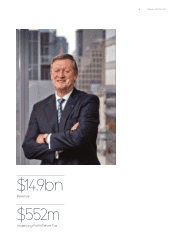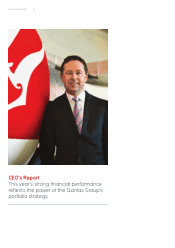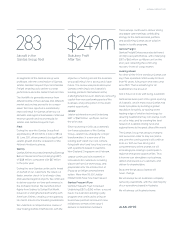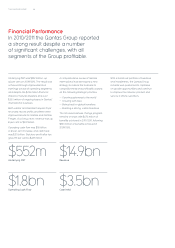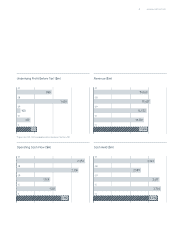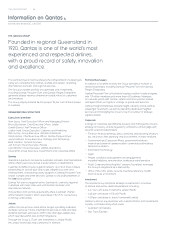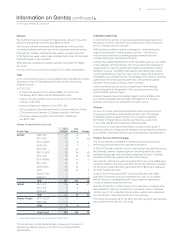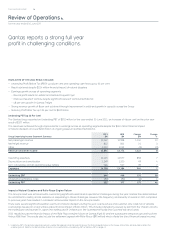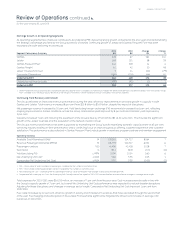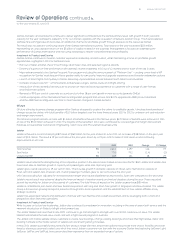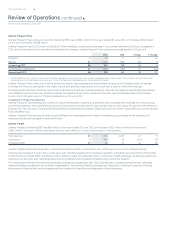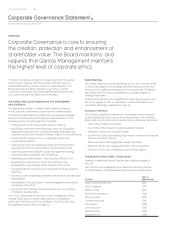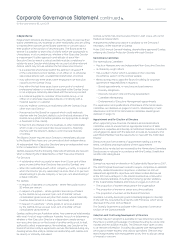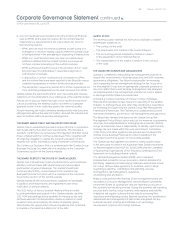Qantas 2011 Annual Report Download - page 17
Download and view the complete annual report
Please find page 17 of the 2011 Qantas annual report below. You can navigate through the pages in the report by either clicking on the pages listed below, or by using the keyword search tool below to find specific information within the annual report.
15 ANNUAL REPORT 2011
for the year ended 30 June 2011
Information on Qantas continued
Network
The Qantas Group is the eleventh largest airline group in the world
based on passenger numbers and distance own.
The Group’s network comprises destinations in countries,
including Australia and those served by codeshare partner airlines.
Domestically, Qantas, QantasLink and Jetstar operate more than
, ights per week. Jetstar also operates more than domestic
ights per week in New Zealand.
Internationally, Qantas and Jetstar operate more than ights
per week.
In / the Group carried a total of . million passengers.
Fleet
At June the Group, including Jetstar Asia and Network Aviation,
operated a eet of passenger aircraft and ve dedicated
freighter aircraft.
In /:
— Qantas took delivery of four Airbus As, one A-,
ve Boeing B-s and one Bombardier Q
— Jetstar, including Jetstar Asia, took delivery of A-s
and two A-s
— Qantas Freight took delivery of one B-
— The acquisition of the Network Aviation Group added two Fokker
Fs and seven Embraer Brasilia aircraft to the eet
— The Group retired one B-, one B-ER and
two B-s
Qantas Group Aircraft in Service
Aircraft Type
Number
Number Change
Qantas A-
B- ()
B-ER -
A-
A- -
B-ER ()
B- ()
B-NG
B- -
Q/Q -
Q
Fokker F -
EMB -
Total
JetstarA-
A- -
A-
Total
Qantas Freight B-SF -
B- -
Total
Total Group
. Jetstar eet includes Jetstar Asia and excludes Jetstar Pacic.
The Group has a comprehensive eet renewal plan focused on
enhancing customer service, fuel efciency and operational
performance.
STRATEGIC DIRECTION
In / the Qantas Group delivered its strongest result since
the global economic downturn and continued to invest in product,
service, infrastructure and growth.
While trading conditions remain challenging – characterised by
high fuel prices and a volatile global economy – the Group is
well-placed to maintain its leading position domestically and
compete strongly in international markets.
Qantas and Jetstar maintained a prot-maximising per cent share
of the domestic air travel market. The Group retains the exibility to
adjust planned capacity growth and capital expenditure to match
demand. A review of Qantas’ international operations was carried
out and established a new ve-year plan to restore the business’s
protability and competitiveness. This strategy is focused on opening
gateways to the world, growing with Asia, being best for global
travellers and building a strong, viable business.
Jetstar continues to pursue its successful pan-Asian strategy,
participating fully in the growth of low-cost leisure travel in the
world’s fastest-growing region.
Qantas Frequent Flyer and Qantas Freight, both protable and
successful businesses add strength and depth to the Group’s
portfolio and enable it to withstand economic cycles.
QFuture
QFuture is a three-year business transformation program aimed
at equipping Qantas for sustainable growth in the increasingly
competitive global aviation market. The program is targeting
$. billion in margin improvements over the three years from
July , with $ billion delivered after two years.
It is focused on business transformation across a wide range of
business areas, including aircraft utilisation and scheduling, alliances,
procurement, information technology and workplace transformation.
Product, Service and Technology
The Group remains committed to introducing new products and
technology that enhance the customer experience.
In / faster, smarter check-in technology was installed across
the domestic network, featuring smart-chip Frequent Flyer cards,
permanent bag tags and automated bag drop facilities. Customer
feedback on the new system has been tremendous.
New aircraft continued to join the Qantas eet. Four more As were
added to Qantas’ long-haul eet, B and A capacity increased
on long-haul routes and next-generation B-s were deployed
on trans-Tasman services.
In late the rst Qantas B to be recongured with A-
standard on-board product will enter service, part of a program
that will ensure a consistently world-class customer experience
across all Qantas long-haul services.
With the introduction of SMS check-in for customers in Australia and
New Zealand, continued investment in self-serve check-in facilities
and the launch of a simplied fare structure, Jetstar also underlined
its commitment to streamlined travel for its customers.
The Group will acquire up to A aircraft to support eet renewal
and growth for the next to years.


